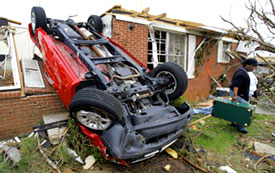Extreme weather leaves path of destruction

(FinalCall.com) – A powerful storm carrying with it several killer tornadoes marched from Minnesota to the Florida panhandle on March 1, leaving dozens of people dead throughout the Deep South, on what was the very first day of the official 2007 tornado season.
Enterprise, Alabama Mayor Kenneth Boswell, whose area was devastated, said parts of his town looked like “ground zero” and there was nothing left. President George W. Bush visited the area Mar. 3, Mayor Boswell said, “with a heavy heart,” trying to comfort those who lost life and property.
In Enterprise alone, there were 18 deaths confirmed, 15 of them at a high school that was thought to be a place of refuge. Students were inside the school when the storm hit, collapsing the roof and walls around some of them.
Some debris from the storm was found as far away as Sumter County, Georgia. A retired farmer in Plains, Ga. found a canceled check from the Citizens Bank of Enterprise blowing in the wind as he drove in a rainstorm Mar. 1.
“It looks as bad from the air as it looks from the ground,” Pres. Bush told reporters traveling with him to view the devastation. “And you can see right here the effects of the storm. But the biggest effect of the storm is the shattered lives…

“These are very tough times for the people here. And there are going to be tough times for the people in Georgia that were affected. And I just hope they know that a lot of people are praying for them, that a lot of strangers that they’ll never have met care for them, and that out of this rubble will emerge a better tomorrow, because that’s the commitment that I hear here in Enterprise,” said Pres. Bush.
“I don’t think there was anything particular about the school that attracted the tornado. Tornadoes normally follow a path dictated by the storms they travel with, so it’s more a case of the school was there in the wrong place, at the wrong time and it just happened to be right dead-center in that tornado’s path,” meteorologist Andrew Humphrey with WDIV-TV Detroit told The Final Call.
One airport worker in Enterprise told reporters the tornado was “ugly-looking” to him, because it was so big. There were tornado reports from 30 places throughout Missouri, Kentucky, Mississippi, Alabama, Georgia, South Carolina, and Florida.
A single system of thunderstorms caused the tornadoes to spin off, according to meteorologists. Warm wet air from the Gulf of Mexico met with cool, dry winds blowing from the West. “These were ideal conditions for the super-cell type of thunderstorms that produce the strong and violent tornadoes that are long-tracked and long-lived,” said meteorologist Dennis Feltgen, according to a published report.
“As they approached Alabama, some of these thunderstorms began to rotate. That’s when you know the storm is especially dangerous,” Mr. Feltgen said.
“I wouldn’t call it unusual per se,” said Mr. Humphrey, “but I think it’s interesting that the first couple of days out of the season, right out of the box, we had this family of tornadoes that sprung up that was so devastating.
“This one particular storm system was responsible for both the huge amounts of snow that we saw in the Midwest, particularly Iowa, and the severe thunderstorms and the tornadoes that occurred down South,” Mr. Humphrey continued. “It’s difficult to tie it to climate crisis or global warming, because climate crisis or global warming really is a matter of monitoring the weather over a course of decades, centuries, or millennia, rather than your typical day-in, day-out weather. It’s something that’s looked at generally after the fact, and it’s difficult to talk about it in present tense,” he said.
These storms are part of “The Judgment of Allah,” on America, the Most Honorable Elijah Muhammad predicted in The Fall of America, written in 1973. “All around the Southern border of America, storms are raging. There are tornadoes and heavy rains and more storms on the way—one right after another. And in the North and Far West, and in the East, America is surrounded with the judgments of Allah (God).” Mr. Muhammad wrote.
The twisters hit Alabama as a deadly winter storm walloped parts of the Plains and Midwest, keeping highways and schools closed, knocking out power and piling up huge snow drifts in the affected areas.
“During this particular time of year, especially in the Deep South and eventually into The Plains and Midwest, you’re talking about tornado season and having to prepare for that,” said Mr. Humphrey. “Into the Spring and into the Summer you’re then talking about not only tornadoes a possibility, also severe thunderstorms and also hurricanes that folks have to watch out for. But it’s something that has to be looked and monitored, every day of every season during every year, just as we have been in the past. It is after those weather events have occurred that we can then take a look at them, research them and see whether that pattern actually fits the norm or does not.”
So far, according to Mr. Humphrey, the severe rash of storms still fits within the time frame of peak tornado season for that part of the country.












